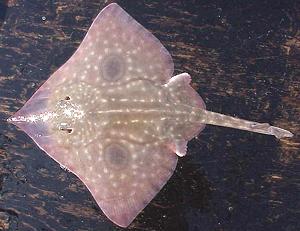 [order Rajiformes (skates): family Rajidae (Skates)
| Order Myliobatiformes (Rays)]
[order Rajiformes (skates): family Rajidae (Skates)
| Order Myliobatiformes (Rays)]
These mostly bottom dwelling fish are really sharks, but have pectoral fins so enlarged they are referred to as "wings". Like all sharks (elasmobranks), skates have no bones, but a skeleton of flexible cartilage. Some skates are listed as endangered (Common Skate, Thornback and Roker) but it's nearly impossible to tell in the market what skate they are selling if it's just wings. No skate or ray is kosher.
Skates and Rays were formerly listed in order Rajiformes, but genetic studies have shown the Rays to have developed their winged form independently of the Skates, so now have their own order Myliobatiformes. For how to tell Skates from Rays see ReefQuest Centre for Shark Research. Photo of Big Skate (Raja binoculata) by the U.S. National Oceanic and Atmospheric Administration = Public Domain.
More on Varieties of Fish
(very large page).
When modern bony fish first came on the scene they started eating all the previous type of fish, placing them under severe evolutionary pressure. Most perished, but some back-evolved features from the primitive fish they themselves had eaten, plus some features much more advanced than those of modern fish. These include live birth, larger brains, a social structure, and in some cases partial warm bloodedness. These adaptation were so successful the following era is called "the age of sharks", and modern fish had to struggle to stay relevant.
Skates and Rays evolved from regular sharks but dropped some of the more advanced features in favor of special adaptions for bottom living. Manta Rays and Eagle Rays later returned to a life of free swiming.
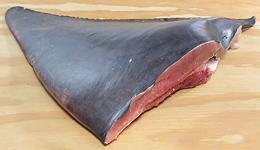 Skate is generally sold as cuts from the wings and is prepared quite
differently from other fish . I haven't seen ray for sale anywhere but
skate wing, and sometimes whole skate can be found (erratically) in
Asian fish markets.
Details and Cooking
Skate is generally sold as cuts from the wings and is prepared quite
differently from other fish . I haven't seen ray for sale anywhere but
skate wing, and sometimes whole skate can be found (erratically) in
Asian fish markets.
Details and Cooking
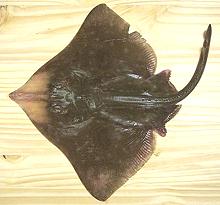 [Raja binoculata]
[Raja binoculata]
Big Skate is found from the Bering Sea to the Mexican border, and
is the most important commercial skate on the west coast of North
America. It is also the largest skate found anywhere around North America,
growing to 96 inches and 200 pounds, but the photo specimen was quite
small at 14-1/2 inches across, 18 inches long and weighed 1.6 pounds. It
was purchased from an Asian market in Los Angeles that serves a mixed
Chinese - Vietnamese community. This skate is IUCN Red List status NT
(Near Threatened) but not enough is known about it to be certain one
way or the other.
Details and Cooking.
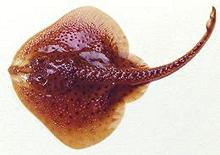 [Leucoraja erinacea]
[Leucoraja erinacea]
This electric skate is found from Nova Scotia, Canada to North Carolina.
Little Skate is used for punching fake scallops out of its wings, but the
main commercial use for it is for baiting lobster traps. It is a small
skate, growing only to 21 inches. Little Skate is IUCN Red
List status NT (Near Threatened).
Photo of Little Skate (Leucoraja erinacea) by Mount
Desert Island Biological Laboratory contributed to the public domain.
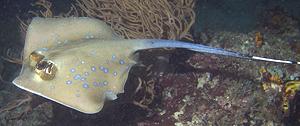 [Order Myliobatiformes; Suborder Myliobatoidei (stingrays)]
[Order Myliobatiformes; Suborder Myliobatoidei (stingrays)]
Rays are related to the sharks, but developed their winged nature
separately from the Skates, so are not as closely related as was once
thought. Stingrays are the most numerous and diverse of the Rays, and
are distinct in having one or more toxic spines, about a third of the
way out their long, whip-like tails. Rays now have their own
Rays & Stingrays page.
Photo of Bluespotted Stingray by Elias Levy, distributed
under license Creative Commons
Attribution Share-Alike v2.0 Generic.